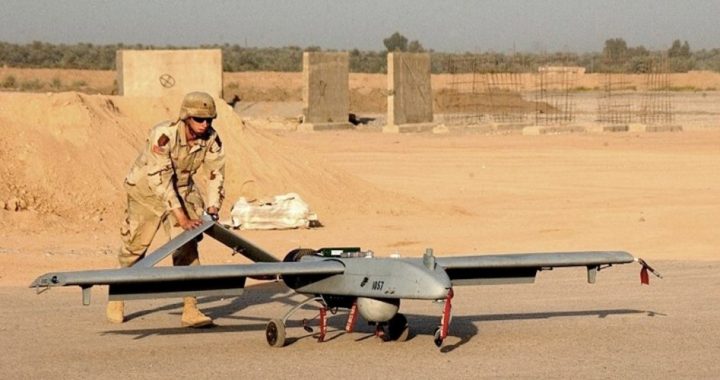
A drone being used by the United States Special Forces has the potential to remain airborne indefinitely if engineers can get the science right. Using lasers beamed from the ground to the unmanned aerial vehicle, the military could send a continuous source of power to the drone allowing it to fly without landing for refueling.
This is the “exciting possibility” demonstrated during an indoor test flight conducted by Lockheed Martin, the manufacturer of the Stalker drone. Lockheed Martin has already developed an electric version of the Stalker that has a two-hour battery life and this latest experiment is an attempt to perfect the technology that will recharge that battery from the ground while the drone remains in flight.
One article describes the frightening potential for such a program: “If proven in actual outdoor flights, [the laser] could give U.S. Special Forces a steady robot friend in the sky to watch for targets or approaching enemies.”
“This test is one of the final steps in bringing laser-powered flight to the field,” said Tom Nugent, president of LaserMotive, the inventor of the laser-based power delivery system used in the test. “By enabling in-flight recharging, this system will ultimately extend capabilities, improve endurance and enable new missions for electric aircraft.”
The test flight of the perpetually deployable drone was conducted in a wind tunnel in order to simulate actual flying conditions. Remarkably successful, the test results demonstrated that by the end of the simulation, the Stalker drone actually had more stored energy than it did at the beginning of the flight.
“We’re pleased with the results of this test,” said Tom Koonce, the Stalker program manager of Lockheed Martin Skunk Works. “Laser power holds real promise in extending the capabilities of Stalker.” Next up for the Skunk Works crew will be testing the laser’s ability to deliver juice to a drone as it flies in the open air.
The Stalker drone has a smaller wingspan (10 feet) and is lighter than most of its larger relatives (the Predator, for example) and is thus a perfect candidate for receiving power from a laser-based source.
Laser technology is being developed at a rapid pace and it seems to be targeted directly at the Constitution.
As we reported July 16, within months the Department of Homeland Security will possess technology that will allow its agents to know everything it wants to know about you without ever touching you. Using a new laser-based scanner that fires a beam from about 164 feet away, the government will be able to see everything it wants to see about your body, your clothes, and what’s in your suitcase. Reports indicate that the soon-to-be-deployed scanner is so powerful that it can detect everything from “what you had for breakfast to the adrenaline level in your body.”
In November 2011, Genia Photonics, the creators of the scanner, was subcontracted by In-Q-Tel to perfect the device for use by the Department of Homeland Security.
The beam used in this scanner is ten million times faster and one million times more sensitive than those currently in use. Imagine the possibilities of a tool so fast and so sensitive: no longer will the TSA be resigned to plucking one or two or even a dozen people out of a security line in the airport. Now, with the Genia Photonics laser, they can scan every single passenger and know so much more than just what he’s carrying. And again, the best part about it is that passengers will never be the wiser. They will never know that their very body chemistry is being monitored and recorded by agents working on behalf of the U.S. government.
Of course, DHS and TSA will not be satisfied with merely being able to quickly detect explosives, chemical, and biological weapons and now they won’t have to be. Reading straight from the promotional material produced by Genia Photonics, the new scanning method (called terahertz spectroscopy) can “penetrate through many dielectric materials, such as clothing, paper, plastics, leather, wood and ceramics.”
Does one often carry wood and ceramics on board an airplane? No, but one certainly finds such objects in a home. Fortunately, for Homeland Security, their new little scanner is very portable and won’t be confined to use in airports or border patrol stations.
Take this bit of boasting from In-Q-Tel as evidence of the ultimate unconstitutional use of the device:
An important benefit of Genia Photonics’ implementation as compared to existing solutions is that the entire synchronized laser system is comprised in a single, robust and alignment-free unit that may be easily transported for use in many environments… This compact and robust laser has the ability to rapidly sweep wavelengths in any pattern and sequence.
Everyone everywhere will now be a potential target for this portable, powerful laser beam. From 164 feet the government can fire a laser beam that can penetrate wood (houses?) and detect important biological data about whatever (whoever) is inside.
One crucial question that is not addressed by Genia Photonics or its promoters at In-Q-Tel is what exactly is the “label-free genetic analysis, and chemical/biological sensing” that will be performed by their machine.
Furthermore, what of the constitutional issues? Who decides whom to target with the laser? Is probable cause no longer a requisite for such intrusive searches and seizures? Will the eye of a magistrate no longer need to look over the shoulder of law enforcement? Are search warrants a thing of the past? Will there be no need for an affidavit “particularly describing the place to be searched and the persons or things to be seized”?
And, why does the government need to know the genetic or chemical makeup of citizens of this Republic?
In a synergy of sinister use of technology, perhaps the Stalker drone could live up to its name and stay aloft perpetually in the skies of the United States using energy delivered via laser, while it uses another laser to scan the homes, cars, and bodies of citizens unaware that a silent drone is aiming an invisible beam at them that is reading and recording biological, chemical, and other critical information.



